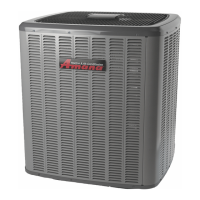SERVICING
42
5. With the system still running, remove hose and reinstall both
valve caps.
6. Check system for leaks.
NOTE: Subcooling information is valid only while the unit is operat-
ing at 100% capacity or 100% of compressor speed in CHARGE MODE.
Compressor speed is displayed under STATUS menu in the thermo-
stat.
S-104 CHECKING COMPRESSOR EFFICIENCY
The reason for compressor inefficiency is that the compressor is
broken or damaged, reducing the ability of the compressor to
pump refrigerant vapor.
The condition of the compressor is checked in the following man-
ner.
1. Attach gauges to the high and low side of the system.
2. Start the system and run CHARGE MODE.
If the test shows:
a. Below normal high side pressure.
b. Above normal low side pressure.
c. Low temperature difference across coil.
d. Low amp draw at compressor.
And the charge is correct. The compressor is faulty - replace the
compressor.
S-105B THERMOSTATIC EXPANSION VALVE
The expansion valve is designed to control the rate of liquid re-
frigerant flow into an evaporator coil in exact proportion to the
rate of evaporation of the refrigerant in the coil. The amount of
refrigerant entering the coil is regulated since the valve responds
to temperature of the refrigerant gas leaving the coil (feeler bulb
contact) and the pressure of the refrigerant in the coil. This regu-
lation of the flow prevents the return of liquid refrigerant to the
compressor.
Some TXV valves contain an internal check valve thus eliminating
the need for an external check valve and bypass loop. The three
forces which govern the operation of the valve are: (1) the pres-
sure created in the power assembly by the feeler bulb, (2) evapo-
rator pressure, and (3) the equivalent pressure of the superheat
spring in the valve.
0% bleed type expansion valves are used on indoor and outdoor
coils. The 0% bleed valve will not allow the system pressures
(High and Low side) to equalize during the shut down period. The
valve will shut off completely at approximately 100 PSIG.
30% bleed valves used on some other models will continue to
allow some equalization even though the valve has shut-off com-
pletely because of the bleed holes within the valve. This type of
valve should not be used as a replacement for a 0% bleed valve,
due to the resulting drop in performance.
The bulb must be securely fastened with two straps to a clean
straight section of the suction line. Application of the bulb to a
horizontal run of line is preferred. If a vertical installation can-
not be avoided, the bulb must be mounted so that the capillary
tubing comes out at the top.
THE VALVES PROVIDED BY THE MANUFACTURER ARE DESIGNED TO
MEET THE SPECIFICATION REQUIREMENTS FOR OPTIMUM PROD-
UCT OPERATION. DO NOT USE SUBSTITUTES.
S-106 OVERFEEDING
Overfeeding by the expansion valve results in high suction pres-
sure, cold suction line, and possible liquid slugging of the com-
pressor.
If these symptoms are observed:
1. Check for an overcharged unit by referring to the cooling per-
formance charts in the servicing section.
2. Check the operation of the power element in the valve as ex-
plained in S-110 Checking Expansion Valve Operation.
3. Check for restricted or plugged equalizer tube.
S-107 UNDERFEEDING
Underfeeding by the expansion valve results in low system capac-
ity and low suction pressures.
If these symptoms are observed:
1. Check for a restricted liquid line or drier. A restriction will be
indicated by a temperature drop across the drier.
2. Check the operation of the power element of the valve as de-
scribed in S-110 Checking Expansion Valve Operation.
S-108 SUPERHEAT
The expansion valves are factory adjusted to maintain 7-9 de-
grees superheat of the suction gas. Before checking the superheat
or replacing the valve, perform all the procedures outlined under
Air Flow, Refrigerant Charge, Expansion Valve - Overfeeding, Un-
derfeeding. These are the most common causes for evaporator
malfunction.
CHECKING SUPERHEAT
Refrigerant gas is considered superheated when its temperature
is higher than the saturation temperature corresponding to its
pressure. The degree of superheat equals the degrees of tempera-
ture increase above the saturation temperature at existing pres-
sure. See Temperature - Pressure Chart on following pages.
CAUTION
To prevent personal injury, carefully connect and
disconnect manifold gauge hoses. Escaping liquid
refrigerant can cause burns. Do not vent refrigerant
to atmosphere. Recover during system repair
or final unit disposal.
1. Run system at least 10 minutes to allow pressure to
stabilize.

